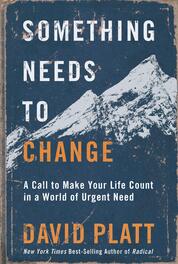 (Click for Amazon link)
(Click for Amazon link) What’s it like to go on a mission trip with David Platt? What would he write in his journal? That’s exactly what you'll see in his latest book (to be published in September). This is not a theological treatise nor a book on Christian living. You are reading into his mission journal on his trip to the Nepalese Himalayas. You’ll be walking in his shoes (without the blisters) as he hikes up the trails and meets interesting people, and everyone that he meets has a back story.
This is just one mission trip, not a collection of several. On the one hand, you can go on your own mission trip and have similar experiences. The conversations that he has with the natives and gospel workers, the things he learns from God in his quiet times, the lessons he learns each day – they are not that uncommon in the mission field. Yet, on the other hand, imagine going on a trip with one of the best mission team leaders. to the most remote parts of the Himalayas. That makes this book worth reading.
His motivation for writing this book is laid out in the last chapter. After you read this, you’re supposed to say to yourself, “Something needs to change!” And you need to practically change something in your life to address the questions that he asks in this book, such as, “How can so many people go to hell?” or “What can I do to help the physical and spiritual needs that are laid bare in this world?
He wants people to take these needs seriously and take real steps to make a difference. This book doesn’t lay out any steps or offer any practical advice. That’s not the point of this book. It’s supposed to get people to start thinking. I’m not sure if he really accomplishes this goal with this book. At any rate, at the least, it was good, pleasure reading.
I would like to thank Multnomah Publishers for an advance copy of this book.
This is just one mission trip, not a collection of several. On the one hand, you can go on your own mission trip and have similar experiences. The conversations that he has with the natives and gospel workers, the things he learns from God in his quiet times, the lessons he learns each day – they are not that uncommon in the mission field. Yet, on the other hand, imagine going on a trip with one of the best mission team leaders. to the most remote parts of the Himalayas. That makes this book worth reading.
His motivation for writing this book is laid out in the last chapter. After you read this, you’re supposed to say to yourself, “Something needs to change!” And you need to practically change something in your life to address the questions that he asks in this book, such as, “How can so many people go to hell?” or “What can I do to help the physical and spiritual needs that are laid bare in this world?
He wants people to take these needs seriously and take real steps to make a difference. This book doesn’t lay out any steps or offer any practical advice. That’s not the point of this book. It’s supposed to get people to start thinking. I’m not sure if he really accomplishes this goal with this book. At any rate, at the least, it was good, pleasure reading.
I would like to thank Multnomah Publishers for an advance copy of this book.


 RSS Feed
RSS Feed
